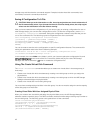
After you have finished creating the disk groups and virtual disks by using the autoConfigure
storageArray command, you can further define the properties of the virtual disks in a configuration
using the
set virtualDisk command. (See Modifying Your Configuration.)
Example Of The Auto Configuration Command
client>smcli 123.45.67.89 -c "autoConfigure
storageArray physicalDiskType=SAS raidLevel=5
diskGroupWidth=8 diskGroupCount=3
virtualDisksPerGroupCount=4 hotSpareCount=2
segmentSize=8;"
The command in this example creates a storage array configuration that uses SAS physical disks set to
RAID level 5. Three disk groups are created. Each disk group consists of eight physical disks configured
into four virtual disks. The storage array has two hot spares, and segment size for each virtual disk is 8 KB.
Modifying Your Configuration
After creating your initial configuration, modify the properties of the configuration to ensure that it meets
your requirements for data storage. Use the following commands to modify the properties of your
configuration:
• autoConfigure storageArray
• create virtualDisk
Use the set commands to modify a storage array configuration. This section explains how to modify the
following properties:
• Storage array password
• Simple Mail Transport Protocol (SMTP) and Simple Network Management Protocol (SNMP) alerts
• RAID controller module clocks
• Storage array host type
• Global hot spares
NOTE: Before modifying your configuration, save a copy of your current configuration to a file (see
Saving A Configuration To A File). If you have problems with your modifications, you can use the
information in the file to restore your previous configuration.
Setting The Storage Array Password
The set storageArray command enables you to define a password for a storage array. The following
syntax is the general form of the command:
set storageArray password="password"
The password parameter defines a password for the storage array. Passwords provide added security to
a storage array to reduce the possibility of implementing destructive commands.
CAUTION: Implementing destructive commands can cause serious damage, including data loss.
NOTE: CLI commands do not have interactive warnings for destructive commands.
Unless you define a password for the storage array, anyone can run all of the script commands. A
password protects the storage array from any command that the RAID controller modules consider
destructive. A destructive command is any command that can change the state of the storage array, such
47


















